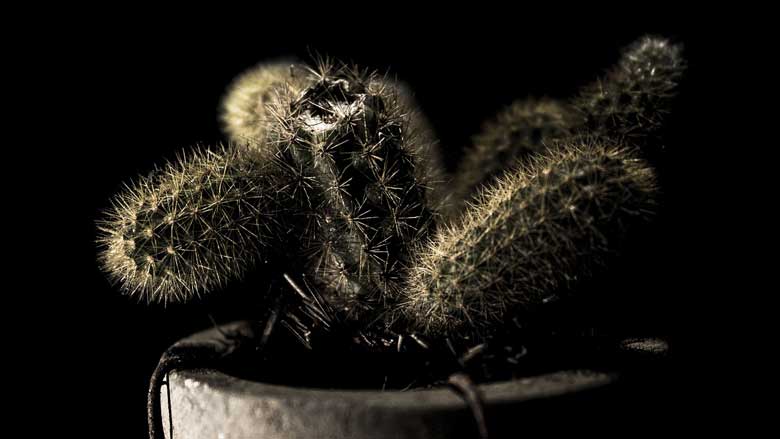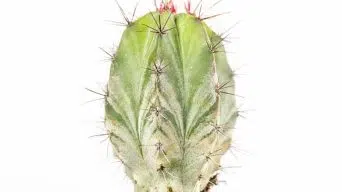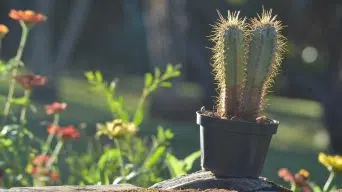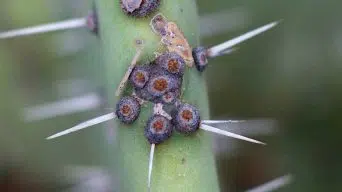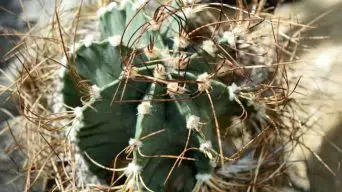Cactus leaning can result from various factors, such as improper soil, pot size, pests, light issues, or watering imbalances. Assess your cactus type and address specific causes like soil stability, pot size, and pest control. Implement preventive measures, like strategic planting and proper watering, to maintain an upright, healthy cactus.
Experiencing your cactus leaning can be quite frustrating for any cactus owner.
When confronted with this issue, the first step is understanding why your cactus is leaning and determining the appropriate action.
There are many reasons that this can happen, and it’s important to know what they are so you can take appropriate action.
The causes of why a cactus is leaning are varied. It can be caused by an issue with the cactus, how it’s planted in potting soil, or a combination of both.
The first thing to do is note what type of cactus you have and where it is leaning on the plant. This will help identify if any specific causes need to be addressed for your particular situation.
This article will discuss why your cactus may be leaning and what you should do if it is.
Causes of Cactus Leaning
Many factors are involved with why your cactus may be leaning, and what you need to do depends on what they are.
Identifying which cause is causing this is essential so you can take appropriate action when trying to fix the problem.
The main reasons why a cactus is leaning are:
1. Sloping Surfaces
The cactus is going to lean if it’s planted in an area with a sloped surface.
Cacti are not plants that can grow on slopes and should be planted on flat surfaces instead of hillsides, or they will lean over time.
Even worse, the cactus may grow sideways and downward if left in this position for too long.
Adjusting Placement for Stability
When growing new plants from seedlings or cuttings, ensure they’re planted on flat ground so they don’t lean over time.
This may seem common sense, but when dealing with something as delicate as a cactus plant, many overlook these details, which inevitably leads to problems later.
2. Potting Soil Issues
Potting soil is often the culprit when a cactus leans.
The cactus soil may not provide enough stability for the plant. It could settle over time and form an uneven surface that causes one side of the cactus to lean more than the other.
After watering a cactus, you should wait until the surface of the soil has dried before watering it again. It is important to make sure that cacti have dry soil.
Overwatering can make potting soil too wet and unstable, leading to cactus leaning.
Correcting Soil Composition
You can also add sand or gravel to the pot, which will help to level out an uneven surface.
To do this, fill one-third of the way up with potting soil before adding a thin layer of sand. It must be leveled so there are no visible signs of anything but moistened dirt at the top.
Place your cactus in the center before filling around its base with more soil until you reach about two-thirds full, followed by another thin layer of sandy soil.
When finishing off, you should avoid packing down too hard because it can lead to excess pressure on your plant’s roots and root rot over time.
Leave space between each slant for maximum stability while retaining good drainage qualities from all sides.
3. Pot Size Problems
At one point in its life, it was most likely a healthy cactus thriving in the ground.
The sudden switch from an expansive space with access to all nutrients and water needed can cause your cactus to start leaning for lack of support.
This happens because there isn’t enough room around the roots, so they struggle to find footing as they would if left in the dirt. This causes them not only to bend but also to break off.
Ensuring Adequate Space for Growth
To remedy this problem, you need either larger pots or more pots, allowing each root system plenty of breathing room while still compact enough. Placing on a flat surface won’t tip over due to weight.
In some cases, the root system may be so weakened that it needs to be forced out of its pot and replanted.
The only way to fix this is by cutting a hole in the bottom of the container and carefully digging around each root individually. Be careful not to damage them or pull on them too hard.
This process can take time but will give your cactus all it needs for healthy growth and keep it from leaning over any more than it already has.
4. Pest Infestation
A pest infestation can cause the cactus to weaken and lean. Pests can chew through the cactus and cause it to fall over.
Certain insects like mealybugs, scale insects, whiteflies, or aphids feed on plants and may push a cactus out of balance with their weight.
Implementing Pest Control Measures
In the case of pests, inspect the plant’s soil to see if they are there.
You can also look at the area around it and on nearby plants for signs of bugs or eggs like cocoons made from silk webs that insects weave in their larval stage.
If you find an infestation, wash off any leaves they touched with soap and water so as not to spread them further.
Then spray a non-toxic pesticide such as insecticidal oil where you found evidence of bug activity (but don’t apply over large areas).
5. Light Issues
If the cactus leans, it may get too much or insufficient light.
The cactus may get too much light in direct sunlight all day and night. This can cause the plant to grow towards the sun, which causes leaning.
The cactus could also get too little sunlight if placed under a tree with dense foliage that blocks most of its natural daylight.
Optimizing Light Conditions
If you suspect your cactus is experiencing issues due to insufficient sunlight, a practical solution is to move it outdoors during the day and at night. This increased exposure to natural light can contribute significantly to its overall well-being.
If your problem is due to excess sunlight, try placing it near an open window or on a shaded porch for part of the day. Move it inside next to artificial lights when not outside.
6. Incorrect Watering
If your cactus is leaning, one of the most likely reasons for this could be incorrect watering.
If you are overwatering or underwatering, this can cause your plant to bend in either direction.
Neither extreme is good, and you must adjust how much water you’re giving your hardy plants depending on their needs.
Adjusting Watering Practices
If they seem thirsty, then give them more.
If excess water comes out of the bottom after a day, reduce the time between weekly watering sessions to once every two weeks.
Technically, all cacti plants need very little water, so don’t worry about overdoing it as long as they aren’t wilting.
Also, remember that different species have different requirements, so research what your plant needs.
7. Temperature and Climate
Cacti are resilient plants adapted to thrive in arid climates with well-draining soil. However, the wrong temperature and climate conditions can contribute to your cactus leaning or exhibiting signs of stress.
Extreme temperatures, especially those outside the cactus’s preferred range, can affect its growth and stability. If your cactus is exposed to prolonged periods of intense heat or cold, it may start leaning as a response to environmental stress.
Additionally, sudden temperature fluctuations, such as rapid drops in temperature during the night, can impact the plant’s ability to take up water properly. This can lead to uneven growth and, eventually, a leaning appearance.
Mitigating Environmental Factors
Consider moving your cactus to a more suitable location to address temperature-related concerns. Placing it in a container with insulating properties can help regulate temperature fluctuations if it’s potted. Providing shade during scorching days or shelter during frosty nights can protect outdoor cacti.
Furthermore, be mindful of the humidity levels in your cactus’s environment. While cacti generally prefer low humidity, excessively dry air can lead to dehydration, prompting the plant to lean. On the other hand, high humidity may contribute to fungal issues, so finding a balance that aligns with your cactus species’ natural habitat is crucial.
Always research your cactus species’ specific temperature and climate preferences to create an environment that fosters optimal growth and stability.
8. Disease and Fungal Issues
Besides cactus rot, the tilting or leaning of your cactus can also result from diseases and fungal issues. While these robust plants are generally resilient to many pests and diseases, they are not invulnerable, particularly in unfavorable environmental conditions.
Fungal infections like root rot and bacterial diseases can compromise the cactus’s structural integrity. These issues often manifest in environments with excess moisture, poor ventilation, or contaminated soil.
Be vigilant for unusual discoloration, wilting, or spots on the cactus’s surface. Changes in the color or texture of the stem may signal an underlying health problem.
Applying Appropriate Treatments
To thwart disease and fungal problems, ensure well-draining soil and prevent water accumulation around the roots. Refrain from overhead watering and promptly remove any dead or decaying plant material.
If you suspect a disease or fungal infection, isolate the affected cactus to prevent spreading to other plants. One solution to this concern is to consider using a fungicide or seeking advice from a gardening professional for targeted treatment.
Early detection and intervention are crucial for effectively addressing disease and fungal issues. Regularly inspect your cactus for signs of distress, addressing problems promptly to maintain the health and upright posture of your beloved succulent.
9. Cactus Rot Issues
A cactus rot issue is a problem with the potting mix that can cause the leaning or falling of a cactus.
This problem typically results when an individual uses poor-quality soil, such as garden loam, to make their potting mix for succulent plants and desert cacti.
The most common symptom of a rotting cactus is that one side (or sometimes two) of the plant will lean toward the ground.
This is due to extra weight from the water building up on top because it cannot drain through the roots at the bottom.
Under these circumstances, a very moist environment can lead to root decay and death if not corrected early in its development stage.
Some other signs are brownish patches near where new growth is emerging from the soil or cracks in the outer surfaces of the cactus.
Remedying Rot Problems
The best way to remedy leaning is by simply correcting what caused it. That means ensuring that your soil has proper drainage and you’re not overwatering your succulent plant regularly.
Suppose you’ve found water building up near a certain point where new growth emerges from the roots.
In that case, this could also mean that there’s no drainage hole close enough to those roots for them to be appropriately drained, too.
What you’ll need to do here is drill one into place (with plenty of airflow).
You can also use pebbles instead of the potting mix as an alternative if drainage isn’t possible. They allow moisture through more easily than garden loam does; they’re best for a cactus plant that naturally has shallow roots.
10. Cactus Age
The age of your cactus can influence its tendency to lean. As cacti mature, they may naturally develop a slight tilt or leaning posture. This leaning is often a regular part of their growth pattern and typically does not indicate any issues.
However, sudden or excessive leaning should prompt consideration of other factors previously discussed, such as incorrect watering or cactus rot.
Some cactus species are recognized for their unique growth habits, including a characteristic lean.
For instance, certain columnar cacti naturally grow taller with a subtle inclination, mirroring the conditions of their environment. It’s crucial to distinguish between a standard growth pattern and an issue necessitating intervention.
If uncertainty persists regarding whether the leaning is due to age or an underlying problem, assess the overall health of the cactus.
A cactus displaying typical growth patterns and overall good health is likely undergoing a natural aging process.
Conversely, if you observe signs of distress, such as discoloration, unusual spotting, or softening of the cactus body, it’s advisable to investigate further and promptly address potential issues.
In summary, while a leaning cactus can be a regular aspect of its growth, understanding the specific characteristics of your cactus species and closely monitoring its overall health will help you distinguish between natural aging and potential problems requiring corrective action.
Remedies for a Leaning Cactus Plant
Addressing a leaning cactus is generally more manageable when the plant is young, allowing greater flexibility in tackling the causes of the lean. However, remedies are available even for more mature cacti.
Here are solutions to correct a leaning cactus:
- Stake Support: For young or small cacti, provide support by staking. Insert a sturdy stake into the soil near the base, avoiding root damage. Gently tie the cactus to the stake using soft ties, allowing it to grow straight.
- Replanting: If the lean is due to pot size or unstable soil, repot the cactus. Choose a larger pot with proper drainage, utilize a well-draining cactus mix, reposition the cactus centrally, and ensure stability by filling in with soil.
- Adjusting Watering Practices: Correct leaning caused by improper watering by adjusting practices. Be mindful of your cactus species’ water needs, let the soil dry between watering, and avoid overwatering to maintain stability.
- Pest Control: Combat leaning caused by pests. Inspect the cactus and surroundings for signs of pests and employ measures like insecticidal soap or oil for elimination.
- Optimizing Light Conditions: Ensure proper light exposure. If leaning results from light issues, relocate the cactus to a spot with better sunlight. If there’s excessive direct sunlight, provide shade during peak heat.
- Temperature and Climate Adjustment: Address temperature concerns by relocating the cactus to a more suitable environment if exposed to extremes. Shield it from abrupt temperature fluctuations affecting growth.
- Disease and Fungal Treatment: If disease or fungal problems surface, isolate the affected cactus and apply treatments. Ensure good ventilation, well-draining soil, and promptly remove any diseased material.
- Cactus Rot Remedies: Correct cactus rot causes like poor soil drainage or overwatering. Ensure proper soil drainage and use materials like pebbles to enhance moisture permeability.
- Monitoring Cactus Age: Understand your cactus species’ growth patterns. If the lean aligns with typical growth habits and the cactus is healthy, it may be a natural aging process.
- Professional Guidance: Seek advice from gardening professionals or cactus specialists if the cause or remedy is uncertain. Their guidance can be tailored to your cactus’s unique characteristics.
Approach corrective measures with care, particularly when dealing with the delicate nature of cacti. Regular monitoring and timely intervention can sustain your cactus’s health and stability.
Preventing Cacti from Leaning
Preventing your cactus from leaning requires proactive measures to ensure stability and structural integrity. Follow these strategies to maintain a straight and healthy cactus:
- Strategic Planting: Choose a suitable location, considering sunlight exposure and wind patterns—plant in a sheltered spot to receive ample sunlight without strong winds, reducing the risk of leaning.
- Proper Watering: Maintain a consistent watering schedule to help the cactus maintain turgor pressure, enhancing structural strength. Avoid overwatering to prevent root rot.
- Supportive Structures: Use stakes or cages for taller or top-heavy cactus varieties to stabilize during rapid growth or adverse weather.
- Gradual Sun Exposure: Introduce your cactus to sunlight gradually, especially if it has been indoors or in a shaded area, to prevent bending or leaning due to sudden intense sunlight exposure.
- Regular Inspection: Routinely inspect the cactus for leaning or imbalance. Early detection enables prompt corrective measures. Adjust the plant’s position or provide additional support if leaning is observed.
- Appropriate Pot Size: If potted, ensure the pot accommodates growth, providing stability and preventing the plant from becoming top-heavy.
- Avoid Disturbances: Minimize disturbances around the cactus to prevent root disruption and compromise stability. Exercise caution during gardening or other activities near the plant.
Incorporate these preventive measures to reduce the likelihood of your cactus leaning and promote long-term resilience. Regular care and attention to environmental conditions contribute to a resilient and upright cactus.
Final Thoughts
It is important to remember that a leaning cactus is not a sign of neglect.
It can happen for many reasons, including the type of cactus, environmental conditions in your home, and how it was planted or transplanted.
With proper care, you should be able to prevent any more leaning cacti from happening. You will be able to enjoy many more years of enjoyment from this drought-resistant houseplant.

